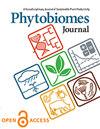Neonicotinoid Seed Treatments Influence Soil Nematode Taxonomic Composition and the Soil Microbial Co-occurrence Networks
IF 2.6
3区 生物学
Q2 MICROBIOLOGY
引用次数: 0
Abstract
Neonicotinoid insecticides are widely used to control early-season and foliar-feeding pests. Some studies have revealed their non-target impacts on pollinators and other invertebrates, but few investigated their effects on soil microbiota. Given the crucial role of soil prokaryotic and eukaryotic microbial communities in agroecosystem regulation and their contribution to soil fertility, it is critical to understand their structure and changes in response to disturbances such as pesticide application. Among these communities, free-living nematodes have the potential to indicate the ecological changes in soil caused by environmental stress and have a key role in forming and modulating soil microbial composition and function by feeding on other soil microorganisms or interacting with them. Here, we used 18S rRNA gene amplicon sequencing to characterize the effects of neonicotinoids on soil nematode communities in a three-year soybean/corn crop rotation in Quebec, Canada. We also quantified the changes in nematode-bacteria co-occurrence networks in soil exposed to neonicotinoids. We found that neonicotinoid seed treatment significantly explained variation in nematode community composition and affected the relative abundance of some nematode families, such as a decrease in the omnivorous family Dorylaimidae in neonicotinoid-treated samples. Moreover, neonicotinoids altered the patterns of nematode-bacteria co-occurrence, including the structure and taxonomic composition of the networks. However, it is unclear whether neonicotinoids affected bacterial co-occurrence networks directly or indirectly by affecting nematodes that feed on bacteria. Further research is needed to understand how neonicotinoids affect nematodes and the role of nematodes in microbial network variation in soil exposed to neonicotinoids.新烟碱类种子处理对土壤线虫分类组成和土壤微生物共生网络的影响
新烟碱类杀虫剂被广泛用于控制早季害虫和叶面取食害虫。一些研究揭示了它们对传粉昆虫和其他无脊椎动物的非目标影响,但很少研究它们对土壤微生物群的影响。鉴于土壤原核和真核微生物群落在农业生态系统调节中的关键作用及其对土壤肥力的贡献,了解它们的结构和对农药施用等干扰的反应至关重要。在这些群落中,自由生活的线虫有可能表明环境压力引起的土壤生态变化,并通过捕食其他土壤微生物或与它们相互作用,在形成和调节土壤微生物组成和功能方面发挥关键作用。在这里,我们使用18S rRNA基因扩增子测序来表征新烟碱类化合物对加拿大魁北克三年大豆/玉米轮作中土壤线虫群落的影响。我们还量化了接触新烟碱类物质的土壤中线虫-细菌共生网络的变化。我们发现,新烟碱类种子处理显著解释了线虫群落组成的变化,并影响了一些线虫科的相对丰度,例如新烟碱类处理样品中杂食性Dorylaimidae科的数量减少。此外,新烟碱类改变了线虫-细菌共存的模式,包括网络的结构和分类组成。然而,目前尚不清楚新烟碱类化合物是否通过影响以细菌为食的线虫直接或间接影响细菌共生网络。需要进一步的研究来了解新烟碱类化合物如何影响线虫,以及线虫在接触新烟碱类物质的土壤中微生物网络变化中的作用。
本文章由计算机程序翻译,如有差异,请以英文原文为准。
求助全文
约1分钟内获得全文
求助全文

 求助内容:
求助内容: 应助结果提醒方式:
应助结果提醒方式:


